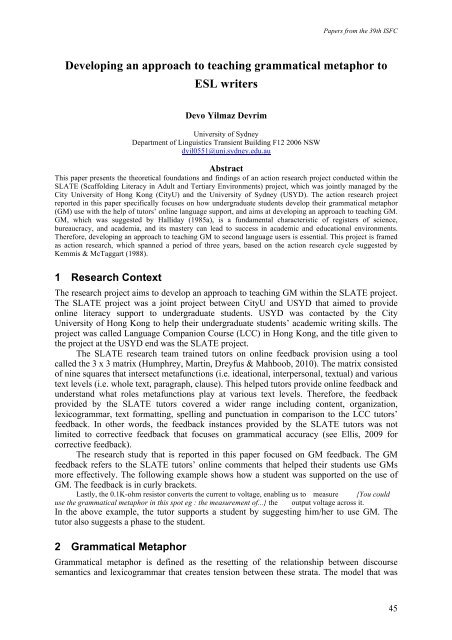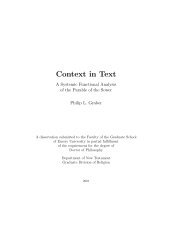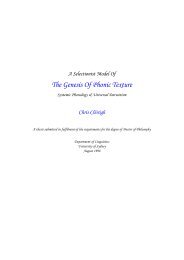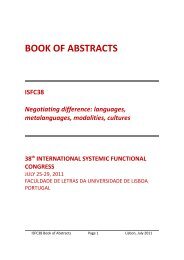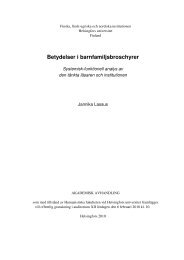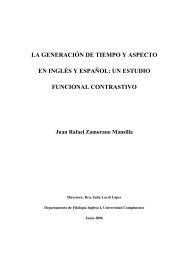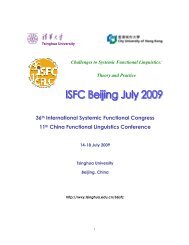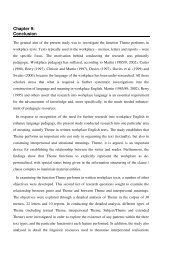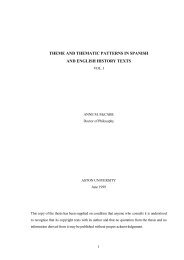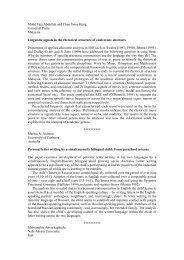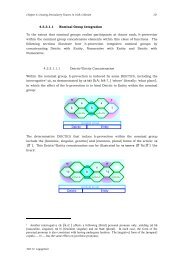the ISFC39 Proceedings - International Systemic-Functional ...
the ISFC39 Proceedings - International Systemic-Functional ...
the ISFC39 Proceedings - International Systemic-Functional ...
You also want an ePaper? Increase the reach of your titles
YUMPU automatically turns print PDFs into web optimized ePapers that Google loves.
Papers from <strong>the</strong> 39th ISFCDeveloping an approach to teaching grammatical metaphor toESL writersDevo Yilmaz DevrimUniversity of SydneyDepartment of Linguistics Transient Building F12 2006 NSWdyil0551@uni.sydney.edu.auAbstractThis paper presents <strong>the</strong> <strong>the</strong>oretical foundations and findings of an action research project conducted within <strong>the</strong>SLATE (Scaffolding Literacy in Adult and Tertiary Environments) project, which was jointly managed by <strong>the</strong>City University of Hong Kong (CityU) and <strong>the</strong> University of Sydney (USYD). The action research projectreported in this paper specifically focuses on how undergraduate students develop <strong>the</strong>ir grammatical metaphor(GM) use with <strong>the</strong> help of tutors’ online language support, and aims at developing an approach to teaching GM.GM, which was suggested by Halliday (1985a), is a fundamental characteristic of registers of science,bureaucracy, and academia, and its mastery can lead to success in academic and educational environments.Therefore, developing an approach to teaching GM to second language users is essential. This project is framedas action research, which spanned a period of three years, based on <strong>the</strong> action research cycle suggested byKemmis & McTaggart (1988).1 Research ContextThe research project aims to develop an approach to teaching GM within <strong>the</strong> SLATE project.The SLATE project was a joint project between CityU and USYD that aimed to provideonline literacy support to undergraduate students. USYD was contacted by <strong>the</strong> CityUniversity of Hong Kong to help <strong>the</strong>ir undergraduate students’ academic writing skills. Theproject was called Language Companion Course (LCC) in Hong Kong, and <strong>the</strong> title given to<strong>the</strong> project at <strong>the</strong> USYD end was <strong>the</strong> SLATE project.The SLATE research team trained tutors on online feedback provision using a toolcalled <strong>the</strong> 3 x 3 matrix (Humphrey, Martin, Dreyfus & Mahboob, 2010). The matrix consistedof nine squares that intersect metafunctions (i.e. ideational, interpersonal, textual) and varioustext levels (i.e. whole text, paragraph, clause). This helped tutors provide online feedback andunderstand what roles metafunctions play at various text levels. Therefore, <strong>the</strong> feedbackprovided by <strong>the</strong> SLATE tutors covered a wider range including content, organization,lexicogrammar, text formatting, spelling and punctuation in comparison to <strong>the</strong> LCC tutors’feedback. In o<strong>the</strong>r words, <strong>the</strong> feedback instances provided by <strong>the</strong> SLATE tutors was notlimited to corrective feedback that focuses on grammatical accuracy (see Ellis, 2009 forcorrective feedback).The research study that is reported in this paper focused on GM feedback. The GMfeedback refers to <strong>the</strong> SLATE tutors’ online comments that helped <strong>the</strong>ir students use GMsmore effectively. The following example shows how a student was supported on <strong>the</strong> use ofGM. The feedback is in curly brackets.Lastly, <strong>the</strong> 0.1K-ohm resistor converts <strong>the</strong> current to voltage, enabling us to measure {You coulduse <strong>the</strong> grammatical metaphor in this spot eg : <strong>the</strong> measurement of...} <strong>the</strong> output voltage across it.In <strong>the</strong> above example, <strong>the</strong> tutor supports a student by suggesting him/her to use GM. Thetutor also suggests a phase to <strong>the</strong> student.2 Grammatical MetaphorGrammatical metaphor is defined as <strong>the</strong> resetting of <strong>the</strong> relationship between discoursesemantics and lexicogrammar that creates tension between <strong>the</strong>se strata. The model that was45


